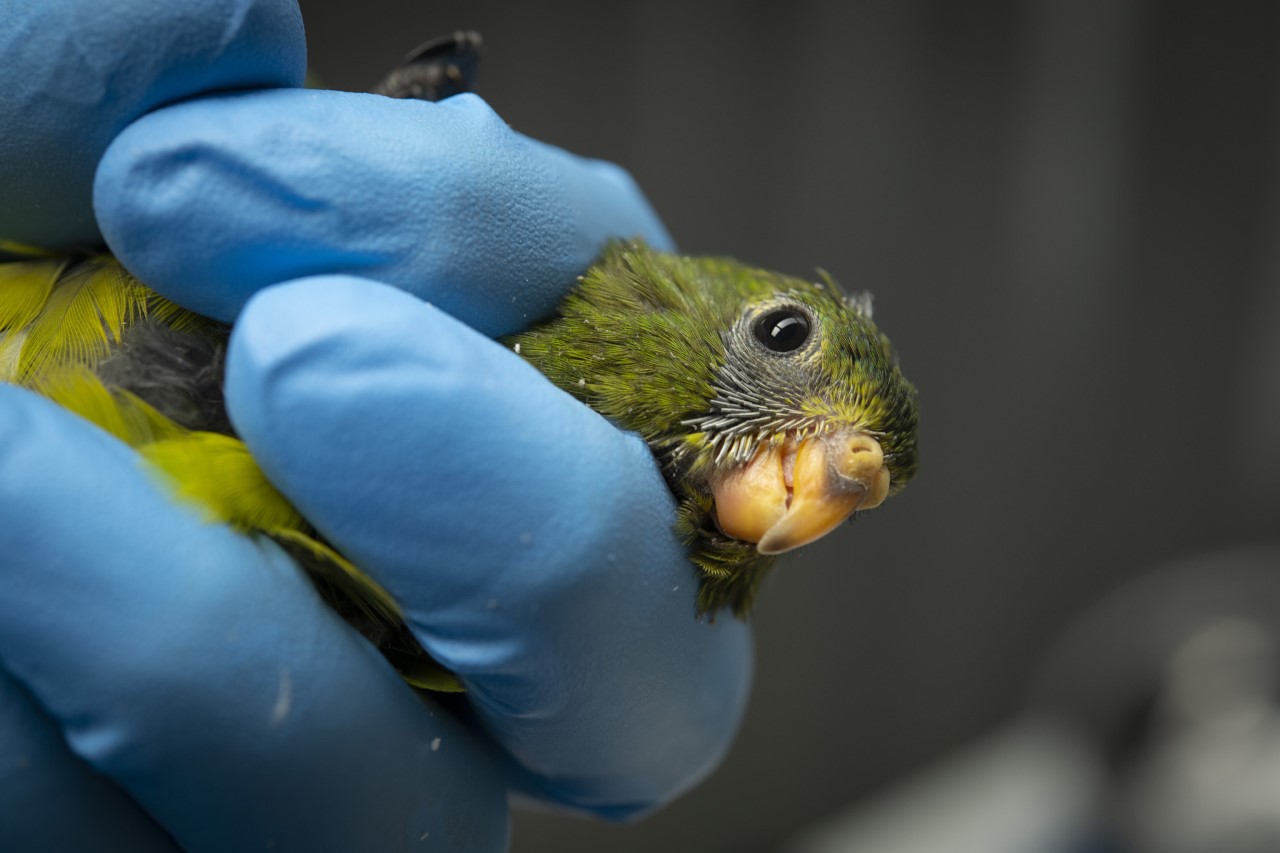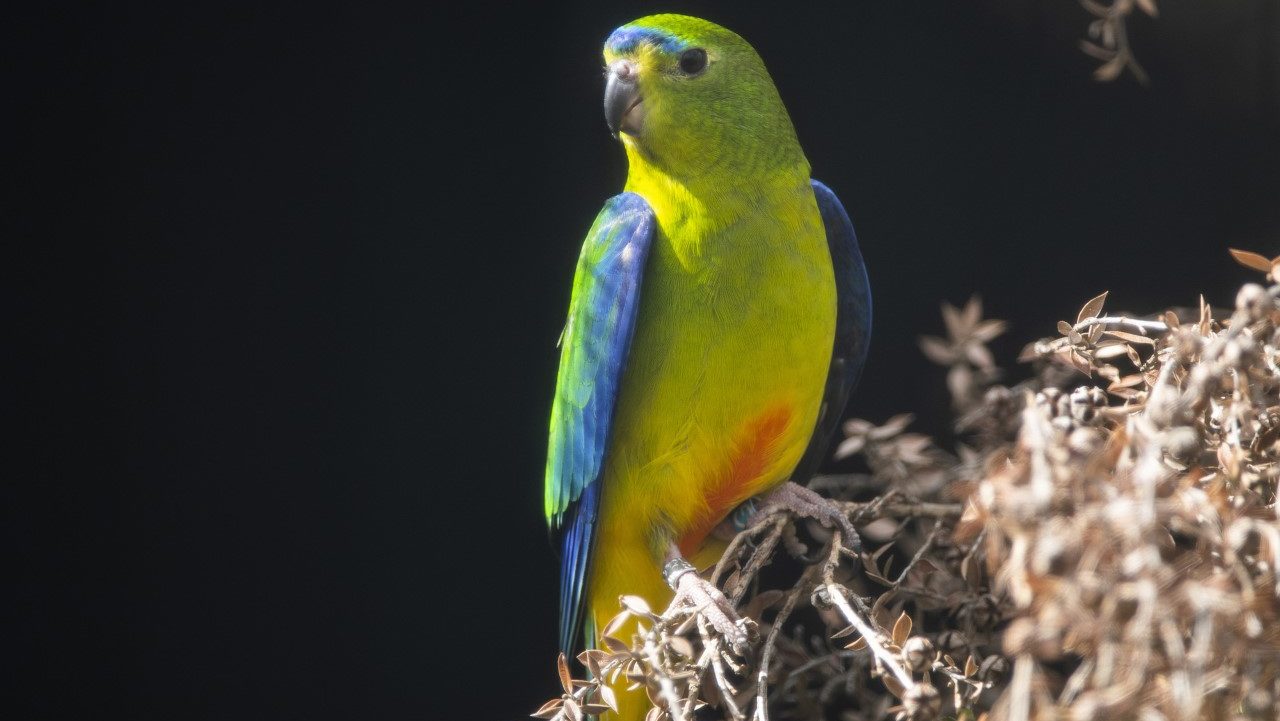Filmmaker Matthew Newton recently gained unprecedented access to the Five Mile Beach Wildlife Management Facility to document the work of a group of dedicated staff and volunteers, rostered on around the clock, breeding and caring for critically endangered orange-bellied parrots (Neophema chrysogaster).
At the time of writing, more than 300 orange-bellied parrots reside at the purpose-built facility as part of the Orange-bellied Parrot Tasmanian Program.
Meanwhile, the wild population fluctuates between 50 and 150 individuals, depending on the season.
In 2016 the species was almost lost forever when just 17 of the birds returned from migration to their breeding ground at Melaleuca, a remote location in Tasmania’s south-west wilderness.
“Only 17 orange-bellied parrots returned to Melaleuca at the start of the 2016/17 season,” says Michael Domrose. “Only four of them were females. They were close to being declared functionally extinct.”
Michael is a Senior Wildlife Officer (Captive) with the Department of Natural Resources and Environment Tasmania (NRE). He works solely with orange-bellied parrots.
He and his team breed these parrots in captivity either to be released into their natural environment, boosting the wild population, or to be kept as part of the captive group as an insurance population.
But there’s a lot that needs to be done – and to go right – before reaching this point.

The challenges of captive breeding
A team of highly-trained wildlife officers, veterinarians and volunteers all work closely with the birds, constantly monitoring their health and development, every step of the way.
The work starts with choosing which birds to pair for mating.
“The program’s species coordinator has all the data on genetic diversity and mean kinship levels,” explains Michael. “She will make recommendations on which birds to pair based on their respective value for the overall population.”
But these scientific calculations “are still not a guarantee that the pair will lay eggs”.
“Sometimes there’s just no pair-bonding. So it’s our responsibility to check for that and break up those pairs and replace one of them with a substitute”.

Even when there is successful pair bonding, there’s no guarantee that their clutches of eggs will be viable.
“If they’re not fertile, we have to remove the clutch because we have limited resources … we don’t have infinite nest boxes and breeding aviaries. So if a breeding aviary is occupied by a female sitting on infertile clutches for months at a time then, of course, that’s taking away the opportunity for us to produce fledglings.”
Parrot parenting
When clutches are fertile, and nestlings hatch successfully, the focus turns to ensuring this next generation survives the early stages of life.
“I don’t think there are many issues in the wild but from a captive point of view, parental parrots can be quite challenging,” says Michael. “Most of them are good but we also have some that are terrible parents.”
He describes three ‘bad parent’ behaviours for which the team is on the lookout, in case intervention is required.
The first is insufficient supply of food, which is most prevalent in larger broods when there are more mouths to feed.
Secondly, the adults can be messy feeders. This “can result in fledglings’ nostrils being covered with food, which becomes dry and hinders, or even makes it impossible to breathe.”
Lastly, there’s ‘feather plucking’, a behavioural disorder characterised by birds chewing, biting or plucking their own feathers with their beaks.
“Plucking is non-existent in the wild, it’s just a captive problem, and sometimes we see the birds engage in ‘parental plucking’ of their nestlings,” says Michael.
“We manage that by either modifying and experimenting with the nest box set-up, or we sometimes give extra enrichment to the parents to keep them occupied … sometimes we have to take the nestlings out and look for other options for them, like suitable foster parents.“
Michael adds that other than these three problems “they are usually okay, that goes for both mum and dad.”

However, birds in general are notorious for concealing any signs of distress or any indications of health problems or injury.
“Because they’re flock birds they try to hide it. They show signs very, very late when it’s nearly too close to assess them in time before they fall off. Little things are very hard to assess, especially in such small birds.”
Because of this, frequent health checks and constant monitoring of the birds is crucial at every stage of life.
“Apart from the need to monitor them, we try to have as little human interaction as possible, to keep them as wild as possible … but we do enjoy watching them though; they are very cute.”
Into the wild
Each year the program supplies captive-bred orange-bellied parrots for two different wild releases.
In spring, adults are released to supplement the depleted number of birds that have returned from migration ahead of the breeding season.
At the end of summer, a group of juveniles is released.
“We get a small airplane carrier in Hobart and send the birds down in little wooden boxes to Melaleuca with one of the wildlife officers or wildlife biologists, where they are usually placed in pre-release aviaries for around 10 days, depending on weather conditions, so they get acclimatised to the conditions in the wild. They can also start socialising with wild parrots that come over, sit on the aviaries and say ‘hello’.”
“Usually after 10 days the hatch will be slowly opened and the parrots that have been translocated can choose when they want to be released. Usually it takes a couple of minutes before they do that.”
And these releases are working. The captive-bred orange-bellied parrots are thriving in the wild.
“Last year all 50 juveniles that were raised in captivity and translocated and released survived at Maleleca until migration,” says Michael. “And in the years before, survival rates have always been high.”

For Michael, it is these successful releases that make all the hard work worthwhile.
“One of the best experiences I’ve had in my entire working life was the first time I went to Malaeuca after having worked with this program for probably two years, and looking after one of the releases.
“There’s this moment when you can see the whole process coming to a close, all the cleaning of aviaries, looking at birds for hundreds of hours, and then getting to that point where these little nestlings that were raised in captivity are now finally being given the opportunity to join the wild flock.
“The hatch of the aviary is opened, and just seeing them going out in the wild was an absolutely breathtaking moment. It still gives me goosebumps when I think about it.”




